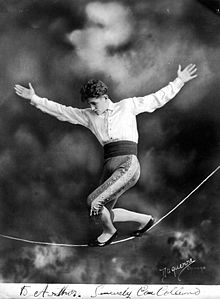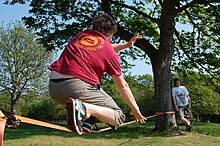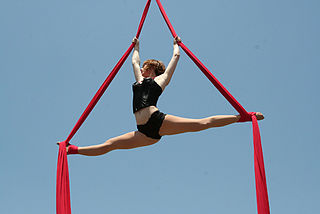
Slackwire (or slack wire) is an acrobatic circus act that involves the balancing skills of moving along a flexible, thin wire suspended in the air, connected to two anchor points. Slackwire is not to be confused with slacklining.

Slackwire (or slack wire) is an acrobatic circus act that involves the balancing skills of moving along a flexible, thin wire suspended in the air, connected to two anchor points. Slackwire is not to be confused with slacklining.
Usually slackwire utilizes a steel wire 4–8 mm (3⁄16–5⁄16 in) in diameter fixed between two anchor points. It can have two single stands with two extending wire pieces each to install the apparatus in an arena, or two A-frame stands with one extending wire piece for each. It can also be mounted between two trees at an appropriate distance apart, or fixed to a ceiling or any points which are strong enough to hold a performer's weight.
Wire walking artists usually use soft shoes made of leather.
A slack rope (or slackrope) is very similar to a slackwire. The difference between a slack rope and a slackwire is in the characteristics of rope and wire. A slack rope usually utilizes a rope 10–20 mm (3⁄8–13⁄16 in) in diameter. The slackwire and slack rope each have advantages and disadvantages for doing stunts. For example, it is easier and more comfortable to do "sliding" tricks on a wire than on a rope. On a slack rope a performer can walk without shoes, a feat that is painful on a slackwire. In addition, a slack rope can be used similarly to a cloud swing.
The performer balances or moves on the wire while needing to control the wire beneath him from moving abruptly side to side, making continual adjustments. This skill is similar to balancing a stick on one’s head or on a finger. Each slackwire performer usually uses their own preferred angle of slack and length of the wire.
The slack angle is the V-shaped angle created when a performer stands in the middle of the walking part of the wire. The angle depends on how long or short the wire is relative to the distance between two anchor points. This also affects the amplitude of the wire's swing side to side. Some slackwire artists change the angle of the wire during their act. [1]
The degree of ease or difficulty for a performer to move the wire is dependent upon how thick the wire or rope is. The heavier the wire or rope, the more inertia is required to move it laterally, and the more force is needed to control its movement or to bring it back to a place of rest.
A wide range of skills and stunts can be performed on the slack wire or slackrope.
Beyond standing and walking, artists can also do turns, lying down, knee stands, sliding, forward and backward rolls, splits, handstands, cartwheels, and headstands. Props such as a ladder, chair, unicycle, bicycle, and even a rola bola have been incorporated into some acts.
Some more advanced slackwire stunts are done while the wire is swinging, including standing, handstands, and walking. Slackwire balancing skills also can be combined with tricks as various kinds of juggling, balancing a stick on the performer’s head, playing a musical instrument, etc. Some of the same skills can be seen in cloud swing or trapeze acts as well.
Jumping rope has been performed on the tightrope and slackline, but is difficult on a slackwire because the wire moves when the performer jumps up, and there is no way to control the swing and position of the wire when landing. This makes such stunts as somersaults and acrobatic tumbling virtually impossible. Jumping rope on a slackwire was first accomplished in 1985. The only person to accomplish the stunt is Sergey Pavlov. Sergey has been able to complete up to seven consecutive jumps. [2] [3]
Slackwire and tightrope appear to be very similar skills to walking and balancing on a thin wire or rope. In fact, the technique of balance is very different between them.

Slackwire and tightwire/tightrope require different balancing techniques: tightrope performers keep their balance by shifting their weight over the rigid tight wire, while slackwire performers use a precise swinging motion to move the relaxed slackwire under their center of mass. Because of this, an artist who works on a tightrope cannot easily make a transition to the slackwire, and vice versa. They need to spend time to train themselves to balance in this different manner.
Some tightwire artists demonstrate a stunt called “the swings”, where the artist takes the position on the wire, then his assistant reduces the tension of the wire and the artist demonstrates swings. This stunt involves multiple skills to maintain balance. After the demonstration the assistant adjusts the wire back to its original tightness. [4]
The same stunt can also be demonstrated on a slackline.

Slackwire and slackline are not the same; they are different kinds of apparatuses that require different techniques of balancing.

Gymnastics is a type of sport that includes physical exercises requiring balance, strength, flexibility, agility, coordination, artistry and endurance. The movements involved in gymnastics contribute to the development of the arms, legs, shoulders, back, chest, and abdominal muscle groups. Gymnastics evolved from exercises used by the ancient Greeks that included skills for mounting and dismounting a horse, and from circus performance skills.

Calisthenics or callisthenics (/ˌkælɪsˈθɛnɪk/) is a form of strength training that utilizes an individual's body weight as resistance to perform multi-joint, compound movements with little or no equipment.

Acrobatics is the performance of human feats of balance, agility, and motor coordination. Acrobatic skills are used in performing arts, sporting events, and martial arts. Extensive use of acrobatic skills are most often performed in acro dance, circus, gymnastics, and freerunning and to a lesser extent in other athletic activities including ballet, slacklining and diving. Although acrobatics is most commonly associated with human body performance, the term is used to describe other types of performance, such as aerobatics.

A mooring is any permanent structure to which a seaborne vessel may be secured. Examples include quays, wharfs, jetties, piers, anchor buoys, and mooring buoys. A ship is secured to a mooring to forestall free movement of the ship on the water. An anchor mooring fixes a vessel's position relative to a point on the bottom of a waterway without connecting the vessel to shore. As a verb, mooring refers to the act of attaching a vessel to a mooring.

A skipping rope or jump rope is a tool used in the sport of skipping/jump rope where one or more participants jump over a rope swung so that it passes under their feet and over their heads. There are multiple subsets of skipping/jump rope, including single freestyle, single speed, pairs, three-person speed, and three-person freestyle.

Tightrope walking, also called funambulism, is the skill of walking along a thin wire or rope. It has a long tradition in various countries and is commonly associated with the circus. Other skills similar to tightrope walking include slack rope walking and slacklining.

A handstand is the act of supporting the body in a stable, inverted vertical position by balancing on the hands. In a basic handstand, the body is held straight with arms and legs fully extended, with hands spaced approximately shoulder-width apart and the legs together. There are many variations of handstands, all of which require the performer to possess adequate balance and upper body strength.
Saltimbanco was a touring show by Cirque du Soleil. Saltimbanco ran from 1992 to 2006 in its original form, performed under a large circus tent called the Grand Chapiteau; its last performance in that form was in Rio de Janeiro, Brazil, on December 10, 2006. A new adaptation of the show started touring North America on July 31, 2007, with its first stop in London, Ontario, Canada. The new version was staged in arenas with fewer performances in each city it visited. The new version closed at the end of 2012.

Slacklining is walking, running or balancing along a suspended length of flat webbing that is tensioned between two anchors. Slacklining is similar to slack rope walking and tightrope walking. Slacklines differ from tightwires and tightropes in the type of material used and the amount of tension applied during use. Slacklines are tensioned significantly less than tightropes or tightwires in order to create a dynamic line which will stretch and bounce like a long and narrow trampoline. Tension can be adjusted to suit the user, and different webbing may be used in various circumstances.

A handspring is an acrobatic move in which a person executes a complete revolution of the body by lunging headfirst from an upright position into an inverted vertical position and then pushing off from the floor with the hands so as to leap back to an upright position. The direction of body rotation in a handspring may be either forward or backward, and either kind may be performed from a stationary standing position or while in motion.

The Russian bar is a circus act which combines the gymnastic skills of the balance beam, the rebound tempo skills of trampoline, and the swing handstand skills of the uneven bars and the parallel bars. The bar itself is a flexible vaulting pole around 4 to 4.5 metres long, typically made of fiberglass; three vaulting poles may also be fastened together to create a flexible beam. The act involves two bases balancing the bar on their shoulders, and one flyer standing on the bar, with the flyer bouncing and performing aerial tricks and landing on the bar.
In rock climbing, an anchor can be any device or method for attaching a climber, rope, or load to a climbing surface—typically rock, ice, steep dirt, or a building—either permanently or temporarily. The intention of an anchor is case-specific but is usually for fall protection, primarily fall arrest and fall restraint. Climbing anchors are also used for hoisting, holding static loads, or redirecting a rope.

A Tyrolean traverse is a method of crossing through free space between two high points on a rope without a hanging cart or cart equivalent. This is used in a range of mountaineering activities: rock climbing, technical tree climbing, caving, water crossings and mountain rescue. A zip-line is in essence a Tyrolean traverse which is traveled down quickly with the assistance of gravity. Several sources claim that the name comes from the Tyrolean Alps, where climbers are said to have developed the system in the late nineteenth and early twentieth centuries.
This is a general glossary of the terms used in the sport of gymnastics.

Nikolas Wallenda is an American acrobat, aerialist, daredevil, high wire artist, and author. He is known for his high-wire performances without a safety net. He holds 11 Guinness World Records for various acrobatic feats, and is best known as the first person to walk a tightrope stretched directly over Niagara Falls. Wallenda walked 1,800 feet (550 m) on a steel cable over Masaya Volcano in Nicaragua, his longest walk, on March 4, 2020.

Ovo is a touring circus production by Cirque du Soleil that premiered in Montréal, Canada in 2009. Ovo's creator and director, Deborah Colker, took inspiration from the world of insects. The idea for Ovo was not to be about the acts, nor dancing, nor insects, but about movement. The movement of life permeates the entire show, with creatures flying, leaping, bounding, and crawling. Composer Berna Ceppas brought additional life to Ovo with a score inspired by the music of Brazil. Ovo means "egg" in Portuguese and represents the underlying thread of the show. Graphically, inside the logo of Ovo, is an insect. The two O's represent the eyes and the V forms the nose and antennas.
Sergey A. Pavlov is a Russian actor, clown, television director, writer and composer

Rope-dancing is the general art and act of performing on or with a rope.